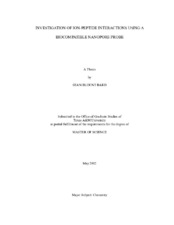| dc.contributor.advisor | Cremer, Paul S. | |
| dc.creator | Bard, Sean | |
| dc.date.accessioned | 2012-07-16T15:57:53Z | |
| dc.date.accessioned | 2012-07-16T20:23:27Z | |
| dc.date.available | 2012-07-16T15:57:53Z | |
| dc.date.available | 2012-07-16T20:23:27Z | |
| dc.date.created | 2012-05 | |
| dc.date.issued | 2012-07-16 | |
| dc.date.submitted | May 2012 | |
| dc.identifier.uri | https://hdl.handle.net/1969.1/ETD-TAMU-2012-05-10852 | |
| dc.description.abstract | The specific manner in which ions associate with a peptide surface is a subject of much research. The models currently proposed tend to rely either on computational results from overly simplified systems, or on observations of bulk solution behavior not applicable to peptide solvation. Herein we demonstrate a new platform for directly measuring specific ion interactions with peptides and use a pair of highly conserved model peptides to investigate specific mechanisms by which ions interact with a peptide surface.
A system for investigation of charge selective ion-peptide interactions using a conical glass nanopore was designed. The glass nanopore was coated using layer-by-layer depositions of poly(diallyldimethylammonium) chloride and sodium poly(styrenesulfonate) to control the size and charge selectivity of the nanopore. The tip of this nanopore probe was encapsulated in a 5% agarose gel to prevent peptide fouling. This probe was then used to measure the partitioning of cations to or from the surface of two model peptides: nonpolar V5-120 and positively charged KV6-112 elastin-like polypeptide (ELP). Partitioning was measured by clamping the current through the pore at zero amps and measuring the resulting potential across the nanopore. This potential was used to determine the bulk concentration of electrolyte in a 1 mg/mL peptide in 0.1 M electrolyte solution.
Measurements were made with a patch clamp using chloride salts with the cations potassium, lithium, cesium, ammonium, and guanidinium at both room temperature and in an ice bath to ensure that the peptides were in their unfolded state and thus that all possible binding sites were exposed to the solution. All salts were observed to partition to the peptide surface with much less affinity than water, resulting in an increase in the bulk electrolyte concentration with the exception of ammonium, which showed a greater affinity than water for the KV6-112 ELP in the ice bath measurements. These results demonstrate that cations do not favorably partition to nonpolar or cationic peptide surfaces. | en |
| dc.format.mimetype | application/pdf | |
| dc.language.iso | en_US | |
| dc.subject | nanopore | en |
| dc.subject | ELP | en |
| dc.subject | elastin-like polypeptide | en |
| dc.title | Investigation of Ion-Peptide Interactions Using a Biocompatible Nanopore Probe | en |
| dc.type | Thesis | en |
| thesis.degree.department | Chemistry | en |
| thesis.degree.discipline | Chemistry | en |
| thesis.degree.grantor | Texas A&M University | en |
| thesis.degree.name | Master of Science | en |
| thesis.degree.level | Masters | en |
| dc.contributor.committeeMember | Soriaga, Manuel P. | |
| dc.contributor.committeeMember | Schweikert, Emile A. | |
| dc.contributor.committeeMember | Musser, Siegfried M. | |
| dc.type.genre | thesis | en |
| dc.type.material | text | en |


